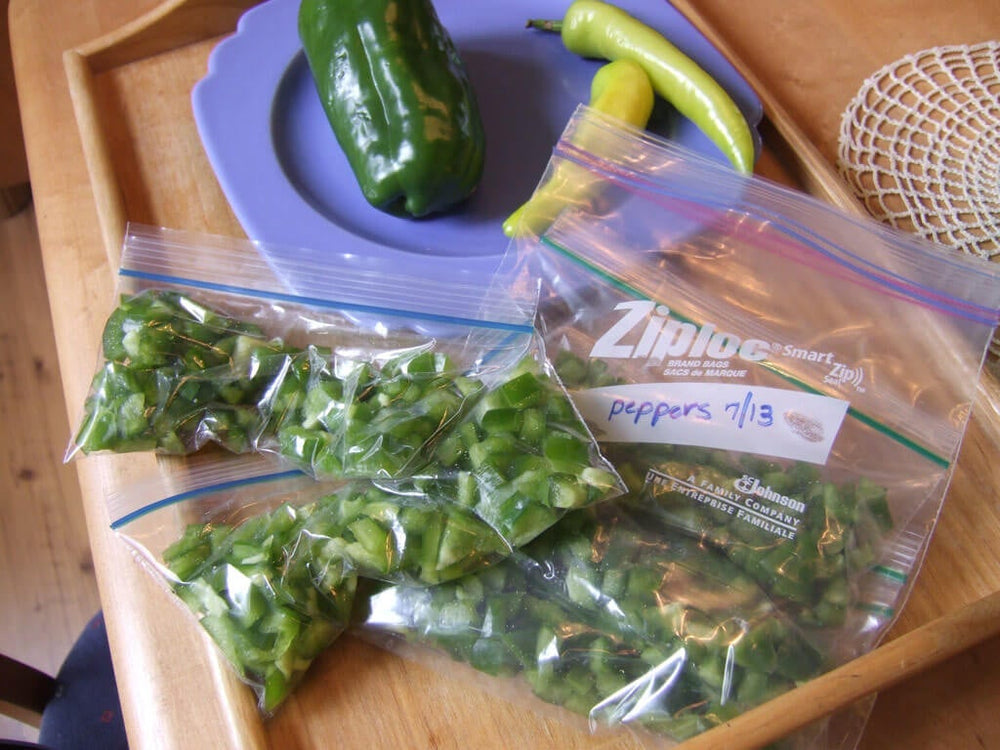For simplicity and speed, it's tough to beat freezing for preserving your garden's homegrown goodness. Frozen vegetables, fruits, and herbs boast fresh-picked flavors long after the growing season ends. In fact, of all the food preservation methods, freezing is the best at keeping your produce's color, quality, and nutrients. What's more, you probably already have all the tools you need to get started.
Equipment you may need
- Containers or freezer bags. Choose materials that are durable, leak-proof, and easy to seal and label. Bags provide flexible storage that makes great use of freezer space. Straight-edged containers boast more space-efficient storage than round ones.
- Ice cube trays for freezing herbs or small quantities of prepared foods, such as pesto, tomato paste, caramelized onions, or winter squash or pumpkin puree.
- A large pot and a large bowl for blanching.
What you can freeze
Vegetables, including:
- artichokes
- asparagus
- green beans
- broccoli
- spinach
- Brussels sprouts
- cauliflower
- corn
- onions
- eggplant
- sweet peas
- peppers
- sweet potatoes
- pumpkin
- summer and winter squash
- tomatoes
Fruits, including:
- melons
- strawberries
- nearly all herbs

Picking and prepping produce
Start with the freshest produce possible. It's okay to remove small spots from food, but if decay has spread into the item, don't freeze it. Peak vegetable ripeness lingers roughly 6 to 12 hours after harvest, so try to freeze food within that window if possible. Be sure to rinse and dry produce before freezing.
Blanching
Most vegetables and some herbs need to be blanched before freezing. Blanching means to scald in hot water for a brief time, then plunge into ice water to halt the cooking process. This neutralizes the enzymes that cause decay, slows vitamin loss, and brightens color. (Blanching spinach, for example, is what allows you to pull beautiful green, flavorful leaves instead of a slimy, darkened blob, from the freezer.) The process also helps remove any dirt and organisms on produce. Most recipes will tell you how long to blanch the produce. Not using a recipe? Check out this guide to blanching times from the National Center for Home Food Preservation (NCHFP).
A few vegetables, such as onions, peppers, and tomatoes, don't require blanching. These items can be frozen whole, sliced, or diced; freeze individual pieces on a tray, or pack them into flexible freezer bags. Tomatoes can be frozen with the skins on; when taken from freezer, the skins will slip off as the tomatoes thaw. Grated zucchini can also be frozen without blanching.
Freezing herbs
Frozen, homegrown herbs infuse dishes with amazing flavor at a fraction of the cost of store-bought dried herbs. Rinse and dry herbs, then freeze using one of these methods. Store in the freezer for up to a year:
- Spread whole or chopped leaves on a paper towel- or parchment-lined tray, freeze for 24 hours, then pack loosely in freezer bags. This works well with herbs such as dill, rosemary, and thyme. When freezing thyme, leave the stems on during the initial freezing process, then toss the stems lightly and the leaves should fall right off.
- For delicate-leaved herbs like basil or oregano, mix with a little olive oil in a blender or food processor to create a slurry, then pour into ice cube trays and freeze. Or, freeze the leaves in water in the trays, then toss cubes into soups, stews, or sauces.
Parsley, chives, cilantro, sage, and tarragon leaves are easy to retrieve from the freezer when rolled like cigars. Place the leaves into the bottom of a freezer bag, then roll it up, removing air as you roll. Secure the roll with rubber bands. To use herbs, slice a chunk from the frozen "cigar".
- Place whole mint leaves in ice cube trays and fill halfway with water. Freeze for two hours, then top with additional water to create a beautiful ice-encased leaf to chill your favorite beverages.

Helpful freezing tips
- Cool food before freezing to help retain natural flavors and colors, and to speed the freezing process.
- Pack food into containers tightly, removing as much air as possible.
- Unless food is loosely packed (e.g. chopped peppers or onions, broccoli florets, etc.), leave head space to allow for expansion after freezing.
- Use freezer tape to seal loose-fitting lids.
- Plan to use frozen harvest within 8 to 12 months. To savor best flavor, follow the NCHFP's guide to freezer shelf life.
- Freeze food in appropriate portion sizes. Herbs or flavorful purees work well frozen in small doses; vegetables tend to be most useful when divided into single meal-sized portions.
- Consider pre-cooking items you're planning to freeze in ways that will speed up meal prep down the road. For instance, caramelize onions, slow-roast tomatoes, cook and puree squash, and roast garlic before freezing.





 Herbs
Herbs
 Vegetables
Vegetables
 Fruit
Fruit
 Flowers
Flowers
 Succulents
Succulents


